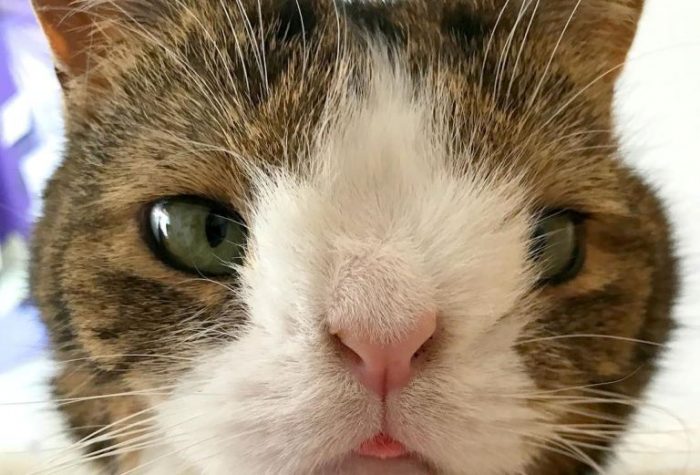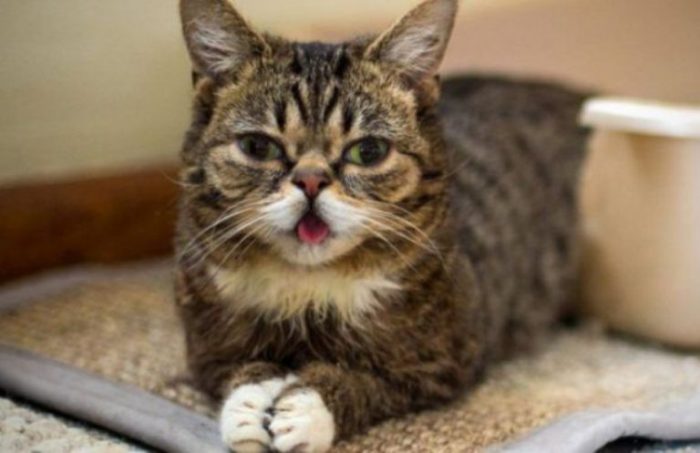Is Down syndrome in cats possible? This is one of the frequently asked questions animal health professionals are constantly faced with. Though the answer to this question comes in the negative, it is quite true that members of the feline population do possess some down syndrome-like symptoms – from quirky physical appearances to unusual behavioral traits. For this write-up, we will be looking at the possible genetic mutations in kitties that can engender those down syndrome-like qualities, including how to know when your feline is displaying such symptoms.
Table of Contents
Down Syndrome Explained
Down syndrome is described as a congenital disorder among humans with both intellectual and physical effects on those diagnosed with the condition. The health problem is a result of a chromosomal defect. The nucleus of each of the cells in humans contains 23 pairs of chromosomes, and victims of Down syndrome have 3 copies, either partial or complete of chromosome 21. Certain physical traits may be evident in such people as short stature, low muscle tone, some degree of learning impairment, a flat nasal bridge, and many more.
The felines have just 19 pairs of chromosomes. What this means in effect is that it is technically impossible to have Down syndrome in cats. This is not to say that they don’t exhibit some down-syndrome-like symptoms.
Can a Cat be Born with Down Syndrome?
Just like in humans, genetic mutations also occur among felines. It is not uncommon to observe both neurological and physical abnormalities among our feline companions.
However, abnormalities that are not within the most common forms of challenging behavior are not necessarily from extra chromosomes or gene mutations.
Furthermore, a cat’s genetic structure is quite distinct from that of humans. Down syndrome is essentially a chromosome irregularity, caused by the creation of what is referred to as a trisomy, or an additional chromosome within the chromosome 21 pairing in humans. Because of the 19 chromosome pairing in cats where humans have 23, a possible trisomy of the chromosome 21 pairing in cats becomes an impossibility.
So, the answer is no, Down syndrome in cats has never been diagnosed, though they do suffer from some neurological and physical abnormalities, which also include other abnormalities involving the chromosomes. Nevertheless, Down syndrome is technically impossible with the feline genetic structure.
How do You Know a Cat with Down Syndrome?
A cat with the condition will exhibit some intellectual impairment fraught with a lack of response to some basic commands like failure to answer when called. Their appearance may be somewhat aloof as if they are not capable of acknowledging their environment properly. The cause of this kind of neurological problem among our furry friends may be laid at the doorstep of genetic or emotional factors. This disorder can be observed in all felines, irrespective of age or breed.
Down Syndrome-Like Signs and Symptoms in Cats
Down syndrome-like symptoms among felines are too numerous, but we are going to discuss a good number of them
- Relative to the slightly slanted and closer-set eyes of the felines, the ones suffering from the condition have rounded eyes that are wide-set. Their ears may look droopy and stunted rather than the normal alert-looking and pointy ears of felines. The button-like and upturned nose is evident as opposed to the gracefully pointed nose. The shape of their faces may also have that slightly off appearance.
- Compared to normal cats, the behavior of felines with Down syndrome is considered abnormal with their wobbly and clumsy movement, as opposed to the normal grace and agile feline movement. Bad coordination is also evident as these cats tend to constantly bump and fall. What’s more, they display strange habits such as sitting and meowing in a different way.
- Also affected is the manner in which the Down syndrome cat would socialize with humans and other household pets. Even in their litter, they exhibit a different behavior from the rest – where their mates shy away from strange and new companions, they tend to embrace any newcomer, and are often friendly. There is also a lack of response when you call them for reprimand.
- Human victims of Down syndrome are susceptible to certain health issues; Down syndrome in cats makes them vulnerable too. In view of this, some cats develop very poor muscle tones, and impaired vision. Detrimental hearing problems are also evident.
- Other symptoms include a perpetually saddened face, upturned eyes, difficulty in excreting, motor dysfunction, hearing loss, and much more.
Genetic Anomalies That May Look Like Feline Down Syndrome

Though Down syndrome does not really occur in cats, the members of the feline population are still susceptible to other genetic anomalies that are similar to Down syndrome. They include:
Cerebral Hypoplasia
One of the genetic conditions that resemble Down syndrome in cats is cerebral hypoplasia. This happens when some parts of a feline’s cerebellum are not developed completely. The symptoms include difficulty with walking and standing, as well as clumsiness that can make the cat experience leg tremors and bob their heads often.
Cerebral hypoplasia may occur as a result of poisoning, malnutrition, or birth defect. The developmental disability has no known cure; you can only manage it by protecting the cat and ensuring that the chances of it harming itself are limited.
Klinefelter Syndrome
Klinefelter syndrome is a genetic condition that causes a male feline to be born with an additional x chromosome. Male calico cats are rare, and when they do occur, they are certain to be born with Klinefelter syndrome. Neutering is not necessary for these males as the condition causes sterility. Some odd behaviors may be observed in the cat, like enticing the other males to come and mate with him. Apart from this, the cat will be relatively normal.
Read Also: How To Use Cat Shock Collar Properly
Distal Polyneuropathy
This is common and a type of nerve damage that is associated with diabetes mellitus, causing numbness or pain in the cat’s limbs. Symptoms include seizures, paralysis, unsteady gait, tremors, and weakness. Diagnosis can be made through urine samples, blood work, or electrophysiology.
Some effective treatments for distal polyneuropathy include nutritional support and electrolyte therapy. However, the underlying cause is what will determine whether the cat will recover or not. If the cause is an allergic reaction, then you just need to alienate your furry friend from the trigger. Important to note that cats with such conditions may not live long.
Feline Dysautonomia
We cannot conclude talks on the genetic conditions that look like Down syndrome in cats without considering feline dysautonomia or Key-Gaskell syndrome.
When there is a failure in the autonomic system affecting the gastrointestinal and urinary tract, it leads to distension in the cat’s bowels, esophagus, and bladder. Symptoms are droopy eyes, swellings, weight loss, loss of appetite, depression, as well as a precariously slow heart rate.
There is no cure available for this condition, you can only treat the symptoms as they occur.
